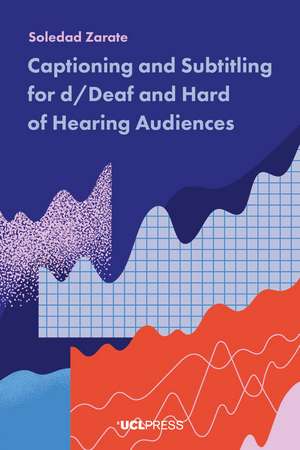Captioning and Subtitling for d/Deaf and Hard of Hearing Audiences
Autor Soledad Zárateen Limba Engleză Hardback – 14 aug 2021
Captioning and Subtitling for d/Deaf and Hard of Hearing Audiences is a comprehensive guide to the theory and practice of captioning and subtitling, with examples and exercises at the end of each chapter. Analyzing the requirements of d/Deaf and hard of hearing audiences in detail, as well as treating the linguistic and technical considerations necessary for effective captioning, this volume will familiarize the reader with the characteristics, needs, and diversity of d/Deaf and hard of hearing audiences. Based on first-hand experience in the field, the book provides a step-by-step guide to making live performances accessible to d/Deaf and hard of hearing audiences. The guide will be valuable reading to students of audiovisual translation, professional subtitlers, and captioners, as well as any organization or venue that engages with d/Deaf and hard of hearing people.
Preț: 291.43 lei
Nou
Puncte Express: 437
Preț estimativ în valută:
55.78€ • 57.48$ • 47.09£
55.78€ • 57.48$ • 47.09£
Carte indisponibilă temporar
Doresc să fiu notificat când acest titlu va fi disponibil:
Se trimite...
Preluare comenzi: 021 569.72.76
Specificații
ISBN-13: 9781787357129
ISBN-10: 1787357120
Pagini: 176
Ilustrații: 19 color plates
Dimensiuni: 159 x 235 x 20 mm
Greutate: 0.52 kg
Editura: UCL Press
Colecția UCL Press
ISBN-10: 1787357120
Pagini: 176
Ilustrații: 19 color plates
Dimensiuni: 159 x 235 x 20 mm
Greutate: 0.52 kg
Editura: UCL Press
Colecția UCL Press
Notă biografică
Soledad Zarate is a lecturer in the School of European Languages, Culture, and Society at University College London.
Cuprins
List of figures List of tables List of abbreviations Preface Acknowledgements 1 Subtitling for d/Deaf and hard of hearing audiences 1.1 The history of subtitles 1.2 SDH within audiovisual translation (AVT) 1.3 Legislation on accessibility 1.3.1 Television and video-on-demand quotas 1.3.2 SDH at the cinema 1.4 The SDH subtitler 1.4.1 The live subtitler 1.5 Discussion points 2 Who is our audience? 2.1 Models of deafness and disabilities 2.2 A spoken language for d/Deaf and hard of hearing audiences 2.3 Deafness 2.3.1 Causes, types and degrees 2.3.2 Hearing devices 2.3.2.1 Hearing aids 2.3.2.2 Cochlear implantation 2.4 d/Deaf children 2.5 Discussion points 3 Linguistic considerations 3.1 Text editing 3.1.1 What can be omitted 3.1.2 Children’s programmes
3.2 Segmentation and line-breaks 3.3 Non-standard language 3.3.1 Children’s programmes 3.4 Orthotypographical conventions 3.4.1 Upper case 3.4.2 Italics 3.4.3 Single and double quotes 3.4.4 Round brackets 3.4.5 Suspension dots 3.4.6 Dashes and hyphens 3.4.7 Symbols 3.5 Discussion points 4 Technical considerations 4.1 Synchronisation between subtitle and sound/image 4.2 Subtitle presentation rates: Reading speeds 4.3 Minimum gap between subtitles 4.4 Shot changes 4.5 Subtitle layout 4.5.1 Font and size 4.5.2 Number of lines 4.5.3 Line length 4.6 Position of subtitle on screen 4.6.1 The safe area 4.7 Subtitle file formats 4.8 Discussion points 5 Specific requirements 5.1 Speaker identification 5.1.1 Colours 5.1.2 Labels and dashes or hyphens 5.2 Paralinguistic features 5.2.1 Accents and pronunciation 5.2.2 Intonation 5.2.2.1 Emphasis 5.2.2.2 Whispering 5.2.2.3 Lyrics 5.2.2.4 Sarcasm 5.2.2.5 Other voice qualifiers 5.2.3 Vocal non-verbal sounds 5.2.4 Pauses and hesitations
5.3 Music 5.4 Sound effects 5.5 Silence 5.6 Discussion points 6 Captioning theatre and subtitling live events 6.1 Captioning theatre plays 6.1.1 Open captioning in theatres around the world 6.1.2 Closed-captioning solutions in theatres 6.1.3 The role of the theatre captioner 6.2 Captioning puppet theatre 6.2.1 The Puppet Theatre Barge 6.2.2 Puppet shows for younger children 6.2.3 Puppet shows for older children 6.2.4 Puppet shows for adults 6.3 Marketing the captioned performance 6.4 Before the captioned performance 6.5 On the day of the captioned performance 6.6 Audience’s feedback on captioned puppet shows 6.6.1 Audience demographics 6.6.2 Visibility of the caption unit 6.6.3 Did captions improve access to or enjoyment of the play? 6.7 Subtitling live events 6.8 Discussion points Appendix 1 Questionnaire collected after a captioned performance Appendix 2 Summary of feedback from captioned puppet shows Appendix 3 Example of subtitles for clip from School of Rock References Films and other audiovisual material Index
3.2 Segmentation and line-breaks 3.3 Non-standard language 3.3.1 Children’s programmes 3.4 Orthotypographical conventions 3.4.1 Upper case 3.4.2 Italics 3.4.3 Single and double quotes 3.4.4 Round brackets 3.4.5 Suspension dots 3.4.6 Dashes and hyphens 3.4.7 Symbols 3.5 Discussion points 4 Technical considerations 4.1 Synchronisation between subtitle and sound/image 4.2 Subtitle presentation rates: Reading speeds 4.3 Minimum gap between subtitles 4.4 Shot changes 4.5 Subtitle layout 4.5.1 Font and size 4.5.2 Number of lines 4.5.3 Line length 4.6 Position of subtitle on screen 4.6.1 The safe area 4.7 Subtitle file formats 4.8 Discussion points 5 Specific requirements 5.1 Speaker identification 5.1.1 Colours 5.1.2 Labels and dashes or hyphens 5.2 Paralinguistic features 5.2.1 Accents and pronunciation 5.2.2 Intonation 5.2.2.1 Emphasis 5.2.2.2 Whispering 5.2.2.3 Lyrics 5.2.2.4 Sarcasm 5.2.2.5 Other voice qualifiers 5.2.3 Vocal non-verbal sounds 5.2.4 Pauses and hesitations
5.3 Music 5.4 Sound effects 5.5 Silence 5.6 Discussion points 6 Captioning theatre and subtitling live events 6.1 Captioning theatre plays 6.1.1 Open captioning in theatres around the world 6.1.2 Closed-captioning solutions in theatres 6.1.3 The role of the theatre captioner 6.2 Captioning puppet theatre 6.2.1 The Puppet Theatre Barge 6.2.2 Puppet shows for younger children 6.2.3 Puppet shows for older children 6.2.4 Puppet shows for adults 6.3 Marketing the captioned performance 6.4 Before the captioned performance 6.5 On the day of the captioned performance 6.6 Audience’s feedback on captioned puppet shows 6.6.1 Audience demographics 6.6.2 Visibility of the caption unit 6.6.3 Did captions improve access to or enjoyment of the play? 6.7 Subtitling live events 6.8 Discussion points Appendix 1 Questionnaire collected after a captioned performance Appendix 2 Summary of feedback from captioned puppet shows Appendix 3 Example of subtitles for clip from School of Rock References Films and other audiovisual material Index
